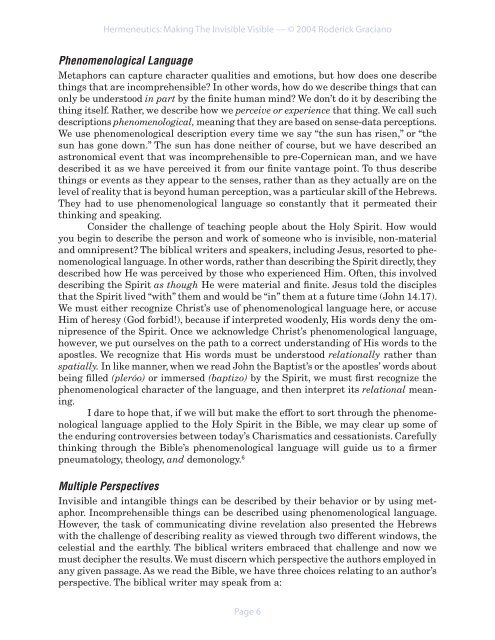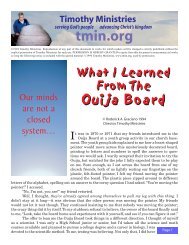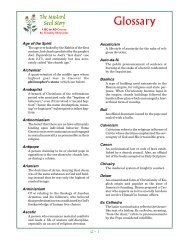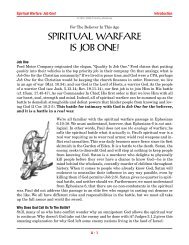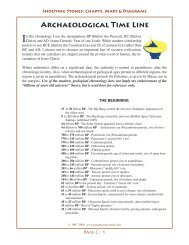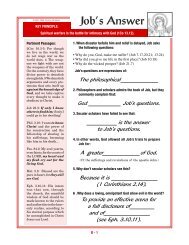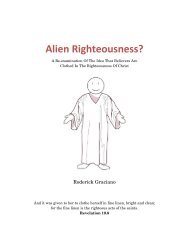Making The Invisible Visible Section 4
Making The Invisible Visible Section 4
Making The Invisible Visible Section 4
You also want an ePaper? Increase the reach of your titles
YUMPU automatically turns print PDFs into web optimized ePapers that Google loves.
Hermeneutics: <strong>Making</strong> <strong>The</strong> <strong>Invisible</strong> <strong>Visible</strong> — © 2004 Roderick Graciano<br />
Phenomenological Language<br />
Metaphors can capture character qualities and emotions, but how does one describe<br />
things that are incomprehensible? In other words, how do we describe things that can<br />
only be understood in part by the finite human mind? We don’t do it by describing the<br />
thing itself. Rather, we describe how we perceive or experience that thing. We call such<br />
descriptions phenomenological, meaning that they are based on sense-data perceptions.<br />
We use phenomenological description every time we say “the sun has risen,” or “the<br />
sun has gone down.” <strong>The</strong> sun has done neither of course, but we have described an<br />
astronomical event that was incomprehensible to pre-Copernican man, and we have<br />
described it as we have perceived it from our finite vantage point. To thus describe<br />
things or events as they appear to the senses, rather than as they actually are on the<br />
level of reality that is beyond human perception, was a particular skill of the Hebrews.<br />
<strong>The</strong>y had to use phenomenological language so constantly that it permeated their<br />
thinking and speaking.<br />
Consider the challenge of teaching people about the Holy Spirit. How would<br />
you begin to describe the person and work of someone who is invisible, non-material<br />
and omnipresent? <strong>The</strong> biblical writers and speakers, including Jesus, resorted to phenomenological<br />
language. In other words, rather than describing the Spirit directly, they<br />
described how He was perceived by those who experienced Him. Often, this involved<br />
describing the Spirit as though He were material and finite. Jesus told the disciples<br />
that the Spirit lived “with” them and would be “in” them at a future time (John 14.17).<br />
We must either recognize Christ’s use of phenomenological language here, or accuse<br />
Him of heresy (God forbid!), because if interpreted woodenly, His words deny the omnipresence<br />
of the Spirit. Once we acknowledge Christ’s phenomenological language,<br />
however, we put ourselves on the path to a correct understanding of His words to the<br />
apostles. We recognize that His words must be understood relationally rather than<br />
spatially. In like manner, when we read John the Baptist’s or the apostles’ words about<br />
being filled (pleróo) or immersed (baptizo) by the Spirit, we must first recognize the<br />
phenomenological character of the language, and then interpret its relational meaning.<br />
I dare to hope that, if we will but make the effort to sort through the phenomenological<br />
language applied to the Holy Spirit in the Bible, we may clear up some of<br />
the enduring controversies between today’s Charismatics and cessationists. Carefully<br />
thinking through the Bible’s phenomenological language will guide us to a firmer<br />
pneumatology, theology, and demonology. 6<br />
Multiple Perspectives<br />
<strong>Invisible</strong> and intangible things can be described by their behavior or by using metaphor.<br />
Incomprehensible things can be described using phenomenological language.<br />
However, the task of communicating divine revelation also presented the Hebrews<br />
with the challenge of describing reality as viewed through two different windows, the<br />
celestial and the earthly. <strong>The</strong> biblical writers embraced that challenge and now we<br />
must decipher the results. We must discern which perspective the authors employed in<br />
any given passage. As we read the Bible, we have three choices relating to an author’s<br />
perspective. <strong>The</strong> biblical writer may speak from a:<br />
Page 6


